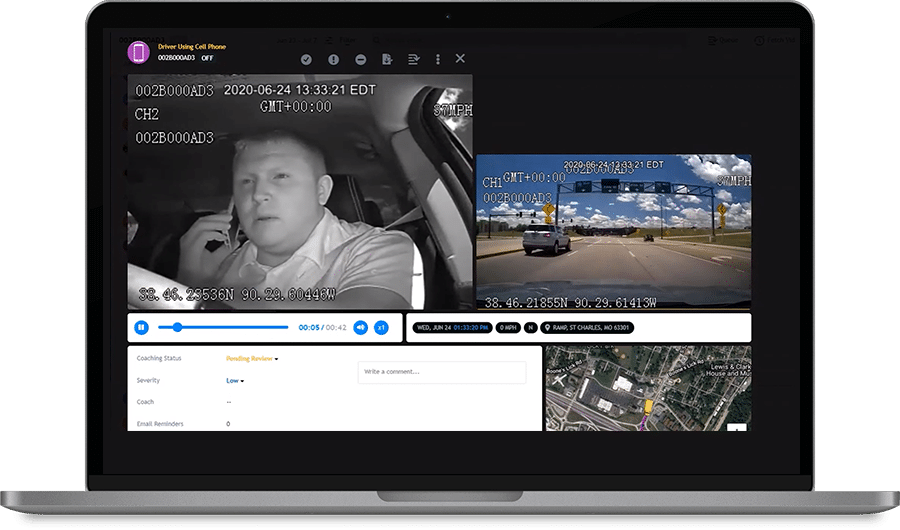The US saw 2,122 deaths in work-related vehicle accidents in 2019. A proper fleet safety program is essential to preventing fatalities like these. In this post, we’ll discuss the benefits of a fleet safety program, what makes an effective one, best practices for creating it, and key challenges you may face along the way. By following these guidelines, you can build a strong foundation for your fleet’s safety culture and prevent your crew from joining the stat line.
Let’s dive in.

Building a positive safety culture requires commitment from both management and drivers. And a strong fleet safety culture has numerous benefits for fleets and businesses.
Benefits include:
Solid fleet safety cultures are built on an easy-to-follow plan, regular safety training, rewards for safe driving, and a proactive vehicle maintenance program.
We can’t stress enough how important simple, easy-to-apply or standardized fleet safety guidelines are for a business. The reason most chains or franchises display continued success is most often not the result of a unique service or product but a standardized process.
Employees come and go. But a standardized process ensures that the team is on the same page and people can plug into the operations with ease. Fleet safety is no different.
Encouraging drivers to prioritize safety through regular training, automated coaching, and incentives boost their road awareness. Frequent accident-free periods can be rewarded to foster safer driving habits.
Fleet managers should prioritize driver coaching on top of in-vehicle monitoring software (IVMS). A 2018 study found that coaching plus IVMS resulted in a decrease in risky driving behavior up to 86% when compared to IVMS alone.
So on top of using IVMS solutions like FleetCam, we strongly recommend adding on automated coaching tools such as DriveShield.

Creating a positive work environment and encouraging open communication with drivers are key in building an effective fleet safety culture. When drivers feel cared for and appreciated, they are more likely to care about the company’s objectives.
The best way to do this is to pay them well, treat them well, and communicate appreciation. According to Rig On Wheels Broker & Recruitment Services, neglecting these are the three top reasons for drivers leaving.
Likewise, effective coaching is essential for developing positive attitudes towards safety, which in turn leads to better driver behaviors and increased satisfaction. This commitment to driver support not only benefits the individual but also contributes to improved fleet-wide safety metrics and reduced accidents.
By taking these steps, you can create a culture where everyone understands their role in maintaining safe driving practices and maintain happier drivers who feel valued and supported.

An effective fleet safety program can also help to significantly improve CSA scores by focusing on areas of driver behavior, vehicle maintenance, and adherence to safety regulations. By providing regular driver training and maintaining strict compliance with vehicle inspections, repair schedules, and cargo-related requirements, a company can reduce the frequency of safety violations.
Fewer violations not only mean safer operations but also improved CSA scores. Furthermore, fleet safety programs that utilize real-time driver feedback and incident recording can help identify risky driving behaviors and areas of improvement, further leading to reduced road incidents and better scores.
These tactics can substantially reduce roadside infractions and crashes, both of which heavily influence CSA scores. Ultimately, an effective fleet safety program plays a crucial role in improving a company’s CSA scores and maintaining a strong safety record.

For a successful fleet safety culture, fleet managers should set clear expectations, provide regular driver training, monitor activity, and reward safe practices.
Clear communication and expectations are key to fostering a robust fleet safety culture and minimizing turnover. Written safety policies provide drivers with a clear reference for their road responsibilities.
Implementing these practices reflects a fleet manager’s commitment to their drivers having the tools they need to do their job. When expectations are clearly expressed and readily available such as in a company app or a printout that’s kept in the vehicle, it’s easier for everyone to fulfill their role in upholding that safe work environment.
Pre-employment screening processes are essential in selecting qualified drivers with good driving records. Regular driver training programs focusing on defensive driving techniques also help to keep the fleet safe.
To ensure an effective fleet safety culture, consider these practices:
By consistently prioritizing education and providing resources for growth, you can cultivate a strong safety culture within your fleet.

Implementing a reward system that acknowledges exemplary driver behavior is an effective way to encourage safe driving practices.
As we’ve mentioned before in our article on insurance & risk management, ‘stick with rewards like cash bonuses or universal gift cards. Your team is trying to pay bills and earn a living.’
By prioritizing recognition and rewards for safe driving, fleet managers can create a positive work environment that supports the fleet safety program.
Creating a culture where employees feel comfortable reporting incidents without fear of retribution and providing incentives when certain goals (such as no accidents) are achieved can also go a long way in promoting fleet safety. Additionally, regular monitoring and feedback are essential components of a successful fleet safety program. Here are some key practices to consider:
An added benefit of regular feedback is that it decreases the chance your drivers will look elsewhere.
For example, Gallup found that employees who received regular feedback on their on-the-job strengths had “turnover rates that were 14.9% lower.”
With regular monitoring and feedback, you can improve driver safety, retain employees, and build a healthier team.

Creating a successful fleet safety program can be challenging due to resistance to change, limited budgets, balancing safety and productivity goals, and compliance regulations. Addressing these challenges is crucial to an effective fleet safety program.
Upper management plays a crucial role in driving change within an organization. However, if there is a lack of buy-in from employees, implementing a safety culture can be challenging. Employee pushback can be a major roadblock in creating an effective fleet safety program.
As such, we strongly recommend you involve employees in the process and address their concerns to gain their support.
Ineffective communication strategies can also lead to misunderstandings and confusion among employees. Clear communication about the importance of safety measures, training programs, and any changes being implemented is essential for success.
Utilize various channels like meetings, newsletters, challenges, or team-building events to help ensure that everyone receives consistent information and feels involved in the process of creating a safer work environment.
Limited budgets can also pose a significant challenge to the development and implementation of a safety program, as many safety initiatives require financial resources. Necessary expenses like regular vehicle maintenance, driver training programs, and investment in safety technology may be difficult to cover.
However, this challenge can be overcome by prioritizing actions that offer the highest safety return for the investment. Start by focusing on driver education and creating a culture of safety that doesn’t require significant financial investment but can yield significant improvements.
Additionally, seek out free or affordable resources and training materials available online or from industry associations. A well-documented safety program (tools included) can also reduce insurance premiums and limit liability in the event of accidents, thereby providing potential cost savings in the long run.
Lastly, consider phased implementation of costly safety technologies, spreading the expenses over a period of time.

Balancing safety and productivity goals can be challenging for fleet managers, but with careful planning, it’s absolutely possible. Here are some tips:
By implementing these steps, fleet managers can ensure that they are not only maintaining a high level of safety but also maximizing productivity.
Lastly, keeping up with regulatory changes is key to fleet safety compliance. Formulating policies aligned with industry best practices and regulations ensures safe, efficient operations.
Regular updates on new requirements helps keep drivers informed of their expectations. Prioritizing compliance creates a safety culture that protects drivers and the business from potential risks.
Ultimately, the best way to improve fleet safety is to create a program and culture with clear objectives and company-wide buy-in. By following these strategies, you’ll be well on your way to a safer fleet.
Fleet safety solutions, such as dash cams, can help fight distracted driving by alerting drivers in real-time when unsafe behaviors are detected. Coupled with safety guidelines that strictly prohibit such behaviors, these tools can significantly improve safety and overall fleet efficiency.
Implementing safety guidelines in your fleet safety program helps reduce road incidents, leading to fewer insurance claims. This can result in lower insurance premiums. Additionally, improved safety contributes to better fleet efficiency, reducing operational costs by minimizing vehicle downtime and repair costs.
Dash cams serve as unbiased eyewitnesses on the road, capturing incidents in detail. They not only alert drivers of unsafe behaviors, helping improve fleet safety, but also provide valuable data to refine safety guidelines. By recording incidents, dash cams provide evidence that can protect against false claims, a secondary benefit that can potentially lower insurance premiums.
Psssst… Want to see how our fleet management tools can help you keep your fleet safe and on the road?
Grab a free demo.
Do it.
Do it now.
Right down here. ⬇️

Recent Posts
Categories
Stay in Touch
Ready to make fleet management more manageable?